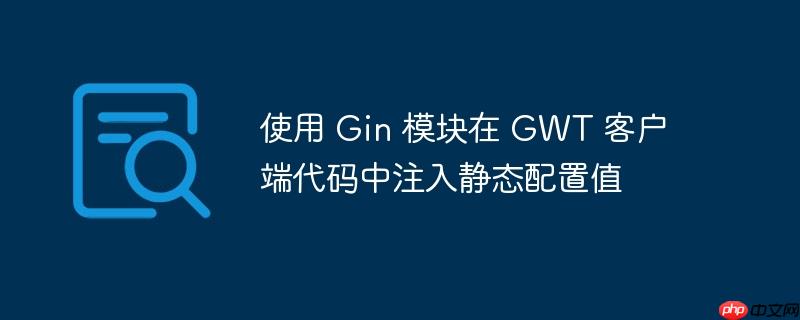
在 GWT (Google Web Toolkit) 项目中,直接在客户端代码中使用 Guice 的 @Named 注解进行依赖注入可能会遇到问题,因为 GWT 客户端代码不支持 Guice 的完整 Java 模拟。本文将介绍一种替代方案,即使用 Gin 模块来解决这个问题,实现在客户端注入静态配置值。
问题描述
当尝试在 GWT 客户端代码中使用 @Named 注解注入配置值时,可能会遇到类似 "You are executing Names.named() in GWT code. GWT does not emulate enough of Java that will work." 的错误。这是因为 GWT 客户端代码无法完全支持 Guice 的所有特性。
解决方案:使用 Gin 模块
Gin 是 GWT 官方推荐的依赖注入框架,专门为 GWT 客户端代码设计。我们可以使用 Gin 模块来绑定静态配置值,然后在客户端代码中注入这些值。
步骤 1:创建 Gin 模块
创建一个类,继承 AbstractGinModule,并在 configure() 方法中绑定配置值。
import com.google.gwt.inject.client.AbstractGinModule;
import com.google.inject.name.Names;
import com.google.inject.Singleton;
public class MyGinModule extends AbstractGinModule {
@Override
protected void configure() {
bindConstant().annotatedWith(Names.named("endpoint")).to("Endpoint URL");
// 可以绑定多个配置值
}
}步骤 2:创建需要注入配置值的类
创建一个类,使用 @Inject 和 @Named 注解来注入配置值。
import com.google.inject.Inject;
import com.google.inject.name.Named;
public class Utility {
@Inject
@Named("endpoint")
private String endpoint;
public String getEndpoint() {
return endpoint;
}
}步骤 3:在 GWT 模块中使用 Gin 模块
在你的 GWT 模块定义文件中(通常是 .gwt.xml 文件),添加以下行来指定 Gin 模块:
<module rename-to='mygwtapp'> <!-- Inherit the core Web Toolkit stuff. --> <inherits name='com.google.gwt.user.User'/> <!-- Inherit the Gin module. --> <inherits name="com.google.gwt.inject.Inject"/> <!-- Specify the application entry point class. --> <entry-point class='com.example.client.MyEntryPoint'/> <!-- Specify the Gin module. --> <gin module='com.example.client.MyGinModule'/> <!-- Other module settings --> </module>
将 com.example.client.MyGinModule 替换为你的 Gin 模块的实际路径。
步骤 4:在客户端代码中使用注入的值
在需要使用配置值的 GWT 客户端代码中,注入 Utility 类,并使用其 getEndpoint() 方法来获取配置值。
import com.google.gwt.core.client.GWT;
import com.google.gwt.uibinder.client.UiBinder;
import com.google.gwt.uibinder.client.UiField;
import com.google.gwt.user.client.ui.Composite;
import com.google.gwt.user.client.ui.Widget;
import com.google.inject.Inject;
public class MyUIPanel extends Composite {
interface MyUIPanelUiBinder extends UiBinder<Widget, MyUIPanel> {
}
private static MyUIPanelUiBinder uiBinder = GWT.create(MyUIPanelUiBinder.class);
@Inject
private Utility utility;
@Inject
public MyUIPanel() {
initWidget(uiBinder.createAndBindUi(this));
}
@Override
protected void onLoad() {
// 使用注入的 Utility 类获取 endpoint
String endpoint = utility.getEndpoint();
// 使用 endpoint 进行操作,例如:
// Window.Location.assign(endpoint);
}
}注意事项
总结
通过使用 Gin 模块,我们可以避免直接在 GWT 客户端代码中使用 Guice 导致的问题,并实现静态配置值的注入。这种方法可以提高代码的可维护性和可测试性,并使 GWT 应用程序更加清晰和易于理解。对于动态配置值,建议使用 GWT RPC 从服务器端获取。
以上就是使用 Gin 模块在 GWT 客户端代码中注入静态配置值的详细内容,更多请关注php中文网其它相关文章!

每个人都需要一台速度更快、更稳定的 PC。随着时间的推移,垃圾文件、旧注册表数据和不必要的后台进程会占用资源并降低性能。幸运的是,许多工具可以让 Windows 保持平稳运行。

Copyright 2014-2025 https://www.php.cn/ All Rights Reserved | php.cn | 湘ICP备2023035733号